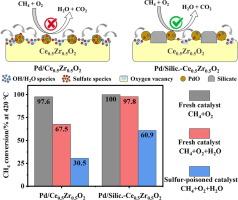通过硅酸盐改性载体性能提高低浓度甲烷燃烧钯/二氧化锆催化剂的耐水和耐硫性能
IF 9
1区 工程技术
Q1 ENGINEERING, CHEMICAL
引用次数: 0
摘要
氧化铈-氧化锆(CeO2-ZrO2)负载的钯(Pd)是一类催化燃烧低浓度甲烷(CH4)的活性催化剂。通过调整载体的表面性质,从而改变金属-载体的相互作用,有望提高催化剂的活性,减轻水蒸气(H2O)和二氧化硫(SO2)引起的催化失活。在本研究中,我们通过硅酸盐沉积来调整Ce0.5Zr0.5O2 (CeZr)载体的表面性能。富集在Ce0.5Zr0.5O2晶体表面的硅酸盐降低了表面Ce3+含量,减弱了载体向钯的电子转移,从而提高了PdO含量和钯的还原性。在260 ℃干燥条件下,硅酸盐改性催化剂的甲烷转换频率(TOF)是Pd/CeZr催化剂的1.3倍。Ce3+含量的降低也降低了表面氧空位的浓度,从而抑制了H2O和SO2在催化剂表面的吸附。当反应气体中H2O含量为10 vol%时,在340 ℃下,硅酸盐改性催化剂的TOF值是Pd/CeZr催化剂的2.1倍,在420 ℃下,这两种催化剂的甲烷转化率分别达到97.8% %和67.5% %。硫中毒后,在360 °C时,硅酸盐改性催化剂的TOF比未改性催化剂高2.5倍,在420 °C时,这两种硫中毒催化剂的甲烷转化率分别达到60.9 %和30.5% %。该研究为开发用于甲烷燃烧的高性能Pd/CeO2-ZrO2催化剂提供了有价值的见解。本文章由计算机程序翻译,如有差异,请以英文原文为准。


Enhanced water and sulfur resistance of a palladium/ceria-zirconia catalyst for low-concentration methane combustion through silicate modifying support properties
Ceria-zirconia (CeO2-ZrO2) supported palladium (Pd) represents a class of active catalysts for the catalytic combustion of low-concentration methane (CH4), a potent greenhouse gas. Adjusting the surface properties of the support and thereby modifying the metal-support interaction are expected to enhance the activity of the catalyst and mitigate catalytic deactivation caused by water vapor (H2O) and sulfur dioxide (SO2). In this study, we adjust the surface properties of the Ce0.5Zr0.5O2 (CeZr) support by silicate deposition. The silicates enriched on the surface of Ce0.5Zr0.5O2 crystallites reduced the surface Ce3+ content, weakened the electron transfer from the support to palladium, thereby enhancing the PdO content and the reducibility of palladium species. The methane turnover frequency (TOF) of the silicate-modified catalyst was 1.3 times that of the Pd/CeZr catalyst at 260 °C under dry conditions. The reduced Ce3+ content also decreased the concentration of surface oxygen vacancies and thereby inhibiting the adsorption of H2O and SO2 on the catalyst surface. When reaction gases contained 10 vol% H2O, the TOF value over the silicate-modified catalyst at 340 °C was 2.1 times higher than that over the Pd/CeZr catalyst, and these two catalysts achieved 97.8% and 67.5% methane conversion at 420 °C, respectively. After sulfur poisoning, the silicate-modified catalyst demonstrated 2.5 times higher TOF than the unmodified catalyst at 360 °C, and these two sulfur-poisoned catalysts achieved 60.9% and 30.5% methane conversion at 420 °C, respectively. This study provides valuable insights into developing a high-performance Pd/CeO2-ZrO2 catalyst for methane combustion applications.
求助全文
通过发布文献求助,成功后即可免费获取论文全文。
去求助
来源期刊

Separation and Purification Technology
工程技术-工程:化工
CiteScore
14.00
自引率
12.80%
发文量
2347
审稿时长
43 days
期刊介绍:
Separation and Purification Technology is a premier journal committed to sharing innovative methods for separation and purification in chemical and environmental engineering, encompassing both homogeneous solutions and heterogeneous mixtures. Our scope includes the separation and/or purification of liquids, vapors, and gases, as well as carbon capture and separation techniques. However, it's important to note that methods solely intended for analytical purposes are not within the scope of the journal. Additionally, disciplines such as soil science, polymer science, and metallurgy fall outside the purview of Separation and Purification Technology. Join us in advancing the field of separation and purification methods for sustainable solutions in chemical and environmental engineering.
 求助内容:
求助内容: 应助结果提醒方式:
应助结果提醒方式:


